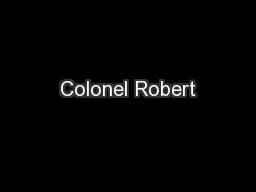

BKleinman By Alberto Gonzalez Chad Anderson Chris Orsbun Colonel Robert B Kleinman was born on June 20 1924 in Brooklyn New York He graduated from Brooklyn Technical High School in 1942 He then received a ID: 188693
Download Presentation The PPT/PDF document "Colonel Robert" is the property of its rightful owner. Permission is granted to download and print the materials on this web site for personal, non-commercial use only, and to display it on your personal computer provided you do not modify the materials and that you retain all copyright notices contained in the materials. By downloading content from our website, you accept the terms of this agreement.
Slide1
Colonel Robert B.Kleinman
By: Alberto
Gonzalez
Chad Anderson
Chris
OrsbunSlide2
Colonel Robert B.
Kleinman
was born on June 20, 1924 in Brooklyn New YorkSlide3
He graduated from Brooklyn Technical High School in 1942. He then received a Bachelor
of Aeronautical engineering in
1949
from Polytechnic
Institute of Brooklyn New York. In 1955 he received his Masters of Science in Engineering from the university of Michigan.Slide4
University of MichiganSlide5
In 1942 he enlisted as an aviation cadet. In Feb.1942
he
received his pilot wings and was commissioned as
Second
Lieutenant in the U.S. Army, Air Corp At Spence field, Georgia. Slide6
Colonel Kleinman
served in
WWII,
he was a pilot in the 436
th fighter squadron and the 479 fighter group stationed at Wattiss ham England. Roberts main responsibility
was to Escort bombers over enemy territory to do bombing
runs,
after escorting bombers safely out of enemy
lines
he would return
to enemy territory to
destroy fuel stations, trains,
and anything the Germans could use.Slide7
The 436 fighter squadron & 479 fighter groupSlide8
The military needed a plane that could make the long travel well over Germany and still make it
back to England.
The
p-51mustang
was the answer. This plane could be equipped with additional external fuel tanks, plus the six
50 caliber
machine guns
that made
this plane a great
mission
changer in the battles over Germany’s skies. Slide9
The P-51 MustangSlide10
Colonel Robert flew 61 combat missions in the
P-51,and
he had over
300
hours of air combat time under his belt. He would complete his European tour and return to the United States in 1945. Slide11
After his WWII tour he returned to active duty in 1949 and was assigned to Keesler
AFB, Mississippi for training in
Atomic
Energy and
Electronics. Now we asked Colonel Robert if he knew at the time if his research was to eventually lead to the Atomic Bomb. He replied by telling us that they were told very little about what their research was for, because of the
need to know
basis
. Slide12
Kleinmans
Atomic
reaserchSlide13
During the Korean War he served as aRadar
officer in an
Aircraft Control and Warning Group
at
Itazuki Japan. During this Korean conflict he was a Commander of a Ground Control Intercept Radar Station and an Early Warning Radar Site. Which meant that he would be the first to know if an attack was coming then he would radio to the main land of a possible attack.Slide14
After his tour in Korea Colonel Robert was selected to attend the Air F
orces
G
uided Missile
program at Horace Racham Graduate school, University of Michigan. He graduated in 1955 where he then went on to Holloman Air Development Center as chief,
Missiles Counter measures
Division. Where he developed early missile electronic vulnerability evaluation techniques for weapon
systems.Slide15
The following two years he served an interservice
tour with the Army
Intergrated
Range
Mission White Sands Roving Ground, New Mexico. This was the end of his ballistic missile career but not the end of his Army career. He then entered a new career in space activity.Slide16
Ballistic MissilesSlide17
From 1959 to 1965 he worked as a system engineer for the “Midas” program
and other Air Force programs. In teams
S
pace
System Division , Los Angeles, he helped pioneer early satellite system development.Slide18
From 1965 to 1969 he was assigned to the Air force Satellite
Control Facility. During
his tour at the
facility
he directed command control and communication efforts to conduct research and development space activities.Slide19Slide20
Successful command and control of a system in orbit
facilitated
accomplishment of mission objectives and return of data from orbit. Though having to do with space this program was separate from NASA. The effective management by the
Field Test Force Director
of the world network provided the system tools to do the job. Slide21
Early satellite retrieval used to be done with an airplane and a hook far different from today's approachSlide22
On May 31, 1979 Colonel Robert retired from the U.S Air Force with 37
years of
service.
Some of
the medals he received were the Legion of Merit with one oak leaf cluster. Also the Distinguished Flying Cross, Meritorious Service Medal with one oak leaf cluster. The Air Medal with nine oak leaf clusters And the Air Force Commendation Medal with three oak leaf clustersSlide23
Some of the Air Force Medals Earned Slide24
On a more personal background Colonel Robert is married to the former Catherine Frake
of
Brooklyn,
New York.
They had three children, LTC Craig Kleinman USAF Ret. Also Keith Kleinman of San Bernardino County Deputy Sherriff Ret. And their daughter Catherine.Slide25
Many years after his service to the military his service was recognized by the secretary of the Air force Special Projects in association between the Department Air Force and the National Reconnaissance Office. Colonel Robert
Kleinman
pioneered and revolutionized Global Space Reconnaissance.